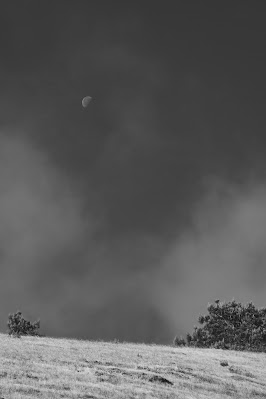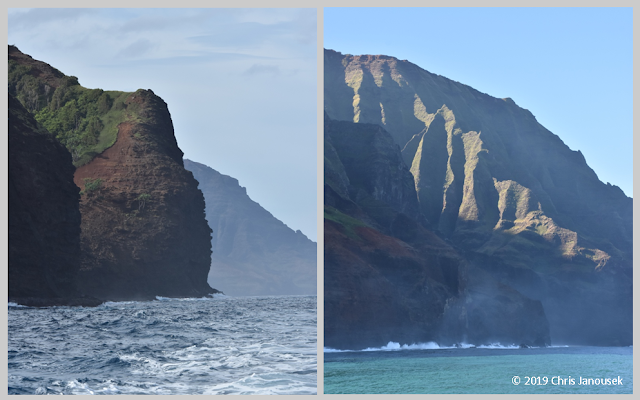Lying just off the coast of Southern California, the Channel Islands are one of the gems of the state. I’ve recently had opportunities to spend time on two of the eight islands – four weeks on Catalina Island last fall to teach a field course (more on that later), and five days this spring on Santa Rosa Island. Santa Rosa is one of five islands that make up Channel Islands National Park. Those five days of camping, hiking, tidepooling, snorkeling, and photographing deserve more than a single blog post, but as I’m finding it difficult to make time to write here, I’ll at least document a few highlights in this post.
Torrey Pine forest. The Torrey Pine (Pinus torreyana) has been described as the rarest member of its genus in the world, growing naturally only in two small geographic regions in California. Populations are found along a thin strip of coastline north of La Jolla and on Santa Rosa Island. Back in my graduate school days, I visited Torrey Pines State Park a few times. While on the island, I hiked to and through the main Santa Rosa population a few times, starting on my first afternoon in the park. The main concentration of trees lies only about a mile or so east of the Water Canyon Campground on the northeast part of the island. The trees grow on a north-facing slope from about the ridge of a hill down to the bluff above the ocean and are present in all sizes from tiny saplings to shrubs to mature trees. Needles on this pine species are in bundles of five and cones are rather rounded. One of the other notable observation about the Santa Rosa grove was the abundance of flowers of various species, a visual treat which repeated itself on other parts of the island during my visit. This past winter the Pacific Ocean was in El Niño conditions, and that oceanographic state brings a decent chance of a wet winter in southern California.
 |
| Immature cone of a Torrey Pine, Santa Rosa Island. |
East Point. Water Canyon Campground was my base camp for the trip from which I fanned out for different day hikes on the island. On my second full day, I made the hike out to East Point, leaving early in the morning. The trail took me through the Torrey pine forest, then southeast down a long valley full of grassland and some shrubs. I took my shoes off to ford a small creek with knee-high water, full of cattails, and then rounded a small estuary. After about three hours, I finally made it to East Point, a rocky point from which the south and east sides of Santa Rosa Island and the west side of Santa Cruz Island could be seen. Elephant seals were common on the beaches north of the point and a few were in the offshore kelp forests in the area, black buoyant snouts sticking out of the water. Although that morning was part of a waning morning of good low tides, I made it in time for the tide and it was good enough to expose an assortment of seaweeds and invertebrates. I explored, photographed, and made notes about intertidal organisms for a while and then made the long hike back to the campground in the afternoon.
 |
| Elephant seals on the east side of the island. |
Lobo Canyon. My second long day trip was to Lobo Canyon, on the north side of the island, a round trip that occupied a full day of exploration. Several people had mentioned this special place, and they were not incorrect. The hike out is rather unimpressive as it takes one through rolling hills covered in dry non-native grasses, but after a few miles beyond the historic ranch, one descends into this botanically and geologically remarkable canyon. Lichen-covered trees cover the sides of the canyon, and in the riparian corridor at the canyon’s bottom (which the trail follows), there are all kinds of interesting plants including willows, horsetails, ferns, and all sorts of flowering species. A ways down the canyon, the remarkable geology becomes prominent. Here are beautifully sculpted patterns in the vertical sandstone bluffs, a delight to photograph. High on one small ledge, a rough next was home to three baby peregrine falcons, ready for their next meal. Finding the nest was a bit of teamwork – a visiting naturalist noted that the canyon was home to these nesting falcons and then I eventually visually spotted the nest’s location. I hiked out to the mouth of the canyon and then a short distance along the island’s north coast to the next small canyon where there was a little waterfall.
 |
| Peregrine falcon nest on a sandstone wall in Lobo Canyon. |
Bechers Bay snorkel and tidepooling. On the drive down to Southern California for this trip I had stopped in Monterey where I purchased a new snorkel mask and hood, and since I had hauled all of my snorkel gear out to the island’s campground, I felt compelled to attempt a snorkel if conditions were favorable and not chicken out due to cold water. By my last full day on the island, the very windy conditions of my first 48 hours on the island had abated considerably and so this was my chance. I opted to explore a very small kelp forest to the south of the landing pier in Bechers Bay. Conditions were calm, though overcast, and the snorkel itself was fine but the water was unfortunately quite murky. To see anything beyond the sparse seaweed canopies reaching the surface, short free dives were necessary. On the mostly sandy bottom, there were urchin barrens in places and other small rocky outcrops with more diverse assemblages of algae and invertebrates in other places. Along with urchins and a few other invertebrates, I saw two large spider crabs (Loxorhynchos grandis), unfazed by my presence. While conditions were much poorer than my snorkeling last fall on Catalina, I’m glad I made the attempt.
 |
| Paintbrushes and lupines in Cherry Canyon. |
 |
| Torrey pines and morning moon, Santa Rosa Island. |



















































